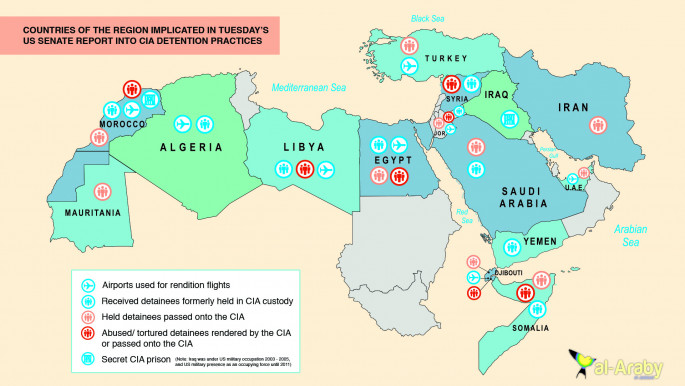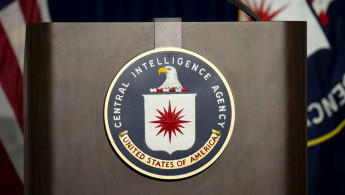A web of complicity in CIA operations
The CIA reportedly enlisted dozens of foreign countries in its abduction and torture operations.
The Open Society Foundation has released a report listing the assistance countries gave to the CIA. Only with foreign aid were US spies able to abduct and transfer captives around their "black sites" without due legal process, and interrogate them beyond the reach of US law.
Some countries were allies, such as Poland and the UK. Others, such as Iran, Syria, and Gaddafi's Libya, were traditional enemies. Here are the main Middle Eastern and North African region countries implicated in the programme.
Algeria
Algeria's vicious civil war in the 1990s led the government target individuals and groups suspected of Islamic militancy. Many of the CIA's captives were Algerian, but, in comparison to other countries in the region, the Algerian involvement was light. Algerian airports are believed to have been used as stops in extraordinary rendition flights. Algeria probably also took custody of people formerly held by the CIA.
Djibouti
The small former French colony is home to a US military base, Camp Lemonnier. Mohammed Ali Isse, a Somali, was transferred there from a US ship. But that was not the only facility involved. Mohammed al-Asad, a Yemeni, was held incommunicado and abused, before later being transferred to a CIA facility in Afghanistan. Another captive, the Kenyan Mohammed Abdulmalik, was held in a shipping container on a US military base and also later flown to Afghanistan.
In 2005 General John Abizaid, the US Army commander for the Central Command, told the US Senate Armed Services Committee that Djibouti had given "extraordinary support for US military basing, training, and counter-terrorism operations".
Egypt
Cairo has been described as one of the most willing accomplices, transferring people abducted from other countries and holding others on behalf of the CIA. Cairo's Tora prison was cited as a custody base. A former captive, Mamdouh Habib, filed a lawsuit against the now deceased Omar Suleiman, who was vice-president of Egypt, and largely responsible for the country's intelligence file, in connection with Habib's detention and torture in the country.
| For full sized map, click here |
Iran
In 2002, Iran transferred 15 prisoners to Afghanistan in an exchange deal. Coming so soon after the US invasion of Afghanistan, the Iranians would have known who they were handing these people to.
Jordan
One of America's biggest allies in the region, and with an economy largely sustained by US aid, Jordan was heavily involved in the CIA's programme. Jordan's General Intelligence Department held captives transferred from other countries by the CIA. Many were later returned to CIA custody. Maher Arar, Jamal al-Mar'i and Abu Hassan al-Suri were among the individuals moved to Jordan by the CIA. Muhammad Farag Bashmilah was also held by Jordanian spies. He reported that, in October 2003, he was transferred to agents who "beat, kicked, diapered, hooded and handcuffed him", before he was transported to a secret CIA facility at Bagram air base in Afghanistan.
Libya
Muammar Gaddafi admitted his role in the Lockerbie bombing, and that seemingly set him on the path to be trusted with dealing with captives transported to Libya by the CIA. Many were associated with the Libyan Islamic Fighting Group, who had fought against Gaddafi in the past. The CIA captured former members of the group across the world and sent them to Libya, where they spent years in prison under Gaddafi. This was despite the CIA knowing Libya's track record on torture. Documents uncovered after Gaddafi's fall show that there was "a close degree of cooperation among the US, the UK, and other Western governments" with regard to these prisoners.
Documents also indicate that the CIA and Libya cooperated in the abduction of Abdul Hakim Belhadj, a leading LIFG member, in 2004. Belhadj reported that he was seized and held in Bangkok and tortured by two CIA officials before being transferred to Libya, where he was questioned by British spies. Belhadj became the new security commander in Tripoli after the fall of the Gaddafi regime.
Mauritania
The government captured, held and interrogated people for the CIA. People captured in Mauritania and transferred to US custody include Saleh Hadiyah Abu Abdullah Di'iki, Mustafa Salim Ali el-Madaghi, and Mohemedou Ould Slahi. In at least one of these cases the captive was interrogated by foreigners and Mauritainian intelligence officers, then dressed in a nappy and hooded by Americans in accordance with "standard CIA rendition transportation procedures" before being moved to Morocco where he was held in a facility that appeared to be "run by Americans".
Morocco
Morocco was home to two sites associated with US abduction programme - the Temara Detention Centre and a second complex near Rabat believed to be specifically for al-Qaeda suspects. Morocco is alleged to have tortured people captured by the CIA and permitted the use of its airspace for flights associated with US operations. Reports from the centres include beatings, slicing and pouring of boiling water on genitals and electrocution.
Saudi Arabia
The kingdom is reported to have captured and held individuals before and after they were subjected to secret CIA imprisonment.
Somalia
The CIA hired Somali factions to kidnap suspected militants, creating what the International Crisis Group termed "a small industry in abductions". According to a Somali militia leader working closely with the US, up to 17 targets were abducted in Mogadishu alone. In July 2011, the Nation reported that Kenyan officials had abducted people suspected of links to al-Shabab to Mogadishu, where they remained imprisoned in the basement of Somalia's National Security Agency HQ. Although Somali officials ran the prison, US intelligence authorities reportedly paid their salaries and US spies interrogated the captives.
Syria
Before the uprising in 2011 this supposed enemy state imprisoned, interrogated, and tortured people abducted by the CIA. Damascus became one of the "most common destinations for rendered suspects". The CIA transferred at least nine captives to Syria between December 2001 and October 2002. Prison facilities made notorious by the civil war were common destinations for the CIA's captives., such as Palestine Branch Prison in western Damascus, were people were held in an area called "the Grave" which consisted of cells roughly the size of coffins.
Turkey
This US ally captured at least one individual subjected to CIA abduction, and also allowed the use of its airport and airspace for CIA flights. According to a leaked diplomatic cable dated 8 June 2006, the then-US ambassador to Turkey Ross Wilson wrote: "The Turkish military had allowed [the US] to use Incirlik as a refuelling stop for Operation Fundamental Justice detainee movement operations since 2002, but revoked this permission in February of [2006]".
United Arab Emirates
The UAE is reported to have captured and held a number of individuals subjected to the CIA's operations. A Yemeni national arrested and held before being transferred to the CIA's control in 2003 described being kept in isolation and tortured for eight months while in the UAE.
Yemen
Home to al-Qaeda in the Arabian Peninsular and notoriously restive, Yemen is a focal point of US activity in the region. The government has also captured and transferred people into US custody at the request of the CIA.





 Follow the Middle East's top stories in English at The New Arab on Google News
Follow the Middle East's top stories in English at The New Arab on Google News


